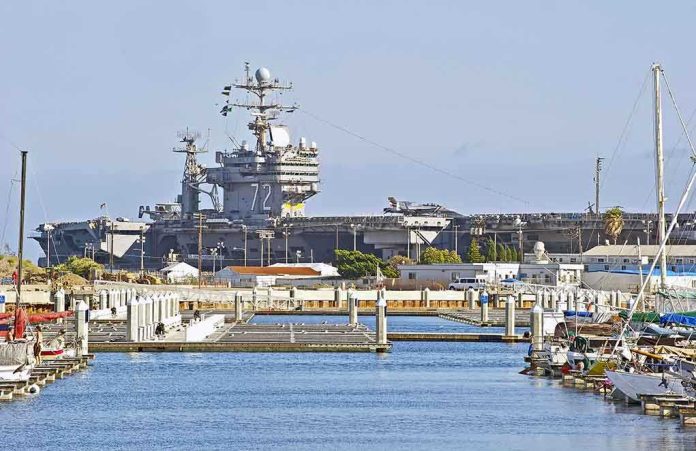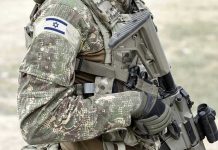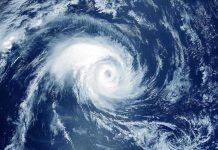
The world’s most advanced warship has just sailed into the Caribbean—raising the stakes for Venezuela, the United States, and anyone watching for the next unpredictable flashpoint in global affairs.
Story Snapshot
- The USS Gerald R. Ford’s arrival marks the largest U.S. military buildup in the Caribbean since the Cold War.
- U.S. officials tie the operation directly to fighting Venezuela-linked drug cartels and “narcoterrorists.”
- Nearly 20% of deployed U.S. Navy warships now operate near Venezuela, fueling speculation about next steps.
- Tensions spike as Washington considers labeling Venezuela’s Cartel de los Soles a foreign terrorist group.
USS Gerald R. Ford’s Arrival Signals a New Chapter in Regional Power
The USS Gerald R. Ford, the pride of American naval engineering, has entered the Caribbean with an entourage of warships, aircraft, and the full force of its air wing. This is not a routine deployment. For the first time in decades, the U.S. Navy’s might is concentrated just off Venezuela’s coast, sending a message that is as unmistakable as it is provocative. The Ford’s arrival on November 16, 2025, follows months of strategic buildup, including amphibious groups and airstrikes on suspected traffickers, culminating in a campaign that directly challenges Venezuela’s government and criminal networks.
The Ford’s deployment is not just about power projection. It is a calculated response to what U.S. officials call an “unprecedented convergence” of narcotics trafficking and state complicity. By targeting Venezuela’s Cartel de los Soles, alleged to be run by senior military officers, and linking operations to counterterrorism authorities, the U.S. has set the stage for a confrontation that goes far beyond interdiction. The region’s geography—close, volatile, and filled with smuggling routes—adds urgency to every move, and the use of advanced autonomous systems suggests a playbook rewritten for the twenty-first century.
Venezuela in the Crosshairs—A Region on Edge
American policy toward Latin America has shifted dramatically in the past year, with President Trump’s administration now treating major cartels as “narcoterrorists” and authorizing military action. Defense Secretary Pete Hegseth’s orders to deploy the Ford strike group make clear that this is not business as usual. For Venezuela, already battered by sanctions and isolation, the U.S. buildup represents an existential threat. The Maduro regime, for its part, has responded with defiant rhetoric and military maneuvers, signaling its intent to resist any intervention.
The power imbalance is stark. The U.S. Navy’s technological edge is overwhelming, from F-35Bs flying off the Ford’s deck to maritime drones patrolling drug corridors. Yet, Venezuela is unlikely to confront the U.S. directly. Instead, it relies on asymmetric tactics, alliances with groups like the Tren de Aragua, and the chaos of transnational crime to complicate American operations. Regional partners such as Trinidad and Tobago and the Dominican Republic have joined joint training missions, but other governments quietly worry about escalation and unintended consequences.
Escalation, Uncertainty, and a Region Holding its Breath
The U.S. operation, dubbed Southern Spear, has already yielded airstrikes and seizures, but officials warn that the hardest choices may lie ahead. President Trump has publicly discussed “next steps,” and the Defense Secretary emphasizes the role of robotics and real-time intelligence. The possibility of designating Cartel de los Soles as a foreign terrorist organization further blurs the line between law enforcement and war, raising the stakes for both governments and civilians caught in the middle.
Nearly one-fifth of America’s deployed warships now patrol the Caribbean, a concentration not seen since the Cold War. Civilian shipping faces rerouted lanes and higher insurance, while regional economies brace for disruption. Security analysts warn that targeting criminal networks with military assets is operationally complex—and the risk of confrontation, miscalculation, or collateral damage grows as forces gather. History shows that U.S. interventions in Latin America often have unpredictable outcomes, and critics argue that this buildup risks destabilizing the region further.
Sources:
Wikipedia: 2025 United States naval deployment in the Caribbean
Stars and Stripes: Gerald Ford enters Caribbean Sea
Politico: US aircraft carrier arrives in the Caribbean in major buildup near Venezuela
CBS News: USS Gerald Ford aircraft carrier arrives Caribbean buildup Venezuela









